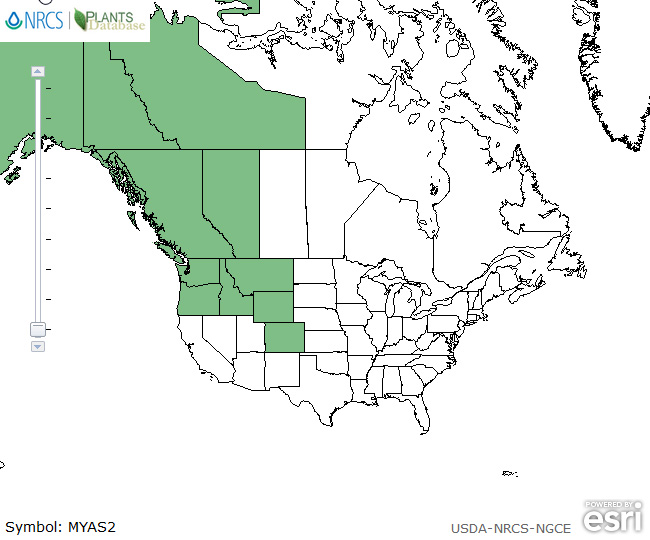Plant of the Week
 Myosotis asiatica range map. USDA PLANTS Database.
Myosotis asiatica range map. USDA PLANTS Database.
 Alpine forget-me-not (Myosotis asiatica). Photo by Edna Charmaine Delmatier.
Alpine forget-me-not (Myosotis asiatica). Photo by Edna Charmaine Delmatier.
 Alpine forget-me-not (Myosotis asiatica) habitat. Photo by Charmaine Delmatier.
Alpine forget-me-not (Myosotis asiatica) habitat. Photo by Charmaine Delmatier.
Alpine Forget-Me-Not (Myosotis asiatica)
By Charmaine Delmatier (2014)
Alpine forget-me-not (Myosotis asiatica; synonyms: Myosotis alpestris, Myosotis alpestris ssp. asiatica, Myosotis sylvatica var. alpestris) is a native perennial to the north-western states and provinces of the United States and Canada. It was designated the state flower of Alaska in 1949 and thought to represent perseverance; a quality which characterized Alaska's first pioneers. Usually located in moist mountainous areas on wooded slopes and grassy meadows, it is restricted to elevations in subalpine and alpine environments, between 7,500 to 10,000 feet. As a limiting factor to most high-altitude plants, its growing season is short; generating flowers and setting fruit must occur between June and September.
A weak slender stem supports a terminal cluster of tiny bright blue flowers which are no wider than 6mm. The five flower petals are fused into a narrow tube, which then flatten into a face of five rounded lobes. The deep blue petals are contrasted with a bright-yellow center, which give forget-me-nots their special attractive appearance. The flower spikes often uncurl like a scorpion tail with the youngest flowers blooming on the upper surface towards the terminal end.
The taxonomy and classification of the Borage family (Boraginaceae) is currently under review by the Flora of North America and associated taxonomists, therefore exact numbers and accepted nomenclature for individual plant species and genera are subject to change. For our purposes, we will recognize the genus Myosotis worldwide has a range of 150 to 200 plant species. Flowers range in color from blue to pink to white and are small, no wider than one centimeter. They are usually flat-faced, five-lobed, and grow in a cluster and are revealed as the scorpioid cyme unravels. Leaves are single, simple, and lance shaped, attached alternately up the stem. Their root systems are generally diffuse. As the plant matures, tulip-shaped fruiting structures (pods) develop along the stem, first at the beginning of the coil, then towards the newer terminal end of fresh flowers.
Most species of Myosotis have coarse hairs. The coarseness is due to its cystoliths; a hard-mineral deposit of silicon dioxide and calcium carbonate which occur in the epidermal cells. This feature is responsible for most skin irritations hikers and gardeners obtain when brushing against these seemingly attractive and delicate flowering forbs. However, it is a beneficial adaptation for distribution; the fruiting pods can easily attach themselves to animals or hikers passing by, or even an enthusiastic gardener, and be shaken loose elsewhere to germinate. As there are several seeds contained in each pod, Myosotis can generate new plants and populations quite easily. In some species, as they age, a change in color will occur from red to blue due to an increase in anthocyanins. It is suggested that this is the signal for pollinators to cease because the reservoir of pollen and nectar is depleted.
Unfortunately, as a popular accent in many gardens for their showy deep blue flowers, some forget-me-nots have escaped as a non-native to wetlands and riverbanks. The true forget-me-not, also known as scorpion weed (Myosotis scorpioides), brought to the United States from Europe is becoming a nuisance by its aggressive invasive tendencies. But there is a simple field test to distinguish the aggressive weedy-like scorpion from our high-altitude forget-me-not; the type of hair on its calyx tube. The hairs on alpine forget-me-not are uncinate (with hooks at the tip of each hair) and are spreading, where the hairs on the scorpion weed are appressed and straight.
Used for its therapeutic properties, forget-me-nots can be used as an astringent in poultices for wounds to tighten tissues. Some contain volatile oils which have been claimed to serve as a diaphoretic to induce sweat and act as an antidote for various poisons.

